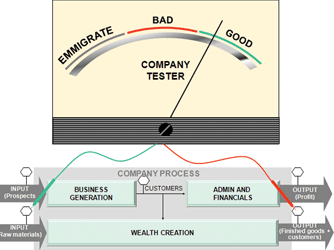

In Parts 1-5 of this series of articles, we have had a brief look at how structuring a manufacturing company as an efficient machine is a good way to go because we know how to build machines and get the most out of them. Making a company a machine and deploying enterprise-wide IT solves a lot of problems but raises a few questions. This final chapter will hopefully answer some of the questions organisations may be asking themselves.
Q: While adopting IT principles in all areas of manufacturing makes sense, we still do not see how this will help unify our company. Could you please explain this clearly?
A: Every process in a company needs information in order to operate. Determining the information needs of these processes brings their functionality and interdependency into the spotlight and allows human operators to see their role in the scheme of things more clearly. They are also now able to see the effects of their performance on the organisation’s other processes. Without enterprise-wide IT this is not possible as ‘departments’ tend to focus narrowly on their own agendas. So, company unification happens largely automatically and as a by-product of enterprise-wide IT – not as an initiative on its own.
Q: Our company is founded on the creativity and responsibility of individuals. You’re now talking about turning it into a machine. That is unacceptable to us. What do you say?
A: When one gets into a car one does not become the car, one simply operates it as the machine it was designed to be. The company, although more complex in some areas, is no different: it is the vehicle for delivering quality goods and profits. People are still the drivers. But what do you want them to drive? A bunch of isolated departments free of logic – of course not. Build the machine and then hire the people to run it because that is what will make them and the machine work in unison and the people prosper. Machines do what humans design them to do, which gives humans more time to exercise their creative talents to improve existing machines or invent new ones. In unified companies, managers do not have to put out fires anymore – in fact, their main purpose is to optimise the processes that are their responsibility. A unified company is one where the processes are complementary and pull together to achieve a common goal. The same goes for the people that run those processes. People who improve processes get rewarded. Those who do not … well … do not. It is all really very simple, logical and far more human friendly than the traditional political and opinion-based systems.
Q: The task of implementing enterprise-wide IT in a large company such as ours seems insurmountable. Not only are we fragmented with respect to our geographically distributed operations but each plant has its own way of doing things that range from accounting to process control. How are we ever going to tackle all these disparities?
A: In short the answer is one step at a time. Contrary to popular belief, the way to enterprise-wide IT is well known and proven. The difficulty lies in wanting to get there. That is why enterprise-wide IT needs to be a top-down process that enlists cooperation rather than one that dictates change – but it needs to be driven.
Horizontally-unified IT already exists in many large and global companies. The ERP layer of a company can communicate globally in order to optimise the use of production resources as well as to synchronise accounting, CRM, HR and many other business processes. MES can synchronise, in the same way, information pertaining to production, maintenance, quality control and inventory management. Process control and scada solutions can now treat geographically distributed manufacturing plants as a single production entity that includes the centralised development and deployment of standards, the optimised use of computing resources and many other aspects that were considered ‘islands of automation’ only a few years ago. The more difficult aspect of IT in manufacturing lies with the vertical integration of these disciplines. But, there are many solutions to choose from today. Standards, solution vendor collaboration and an end-user driven market are all helping to create an environment where unified manufacturing companies will become prevalent.
So, getting back to the question, many solutions exist. What is required is to look at them critically in the context of the organisations needs. Start by implementing those that make the most sense, bearing in mind that the first things to get right are the business generating and wealth creating processes.
Q: We have had many ‘flash in the pan prophecies’ in the past that amounted to expensive dead-ends. How do we know that this is any different?
A: What has been presented in the preceding articles is a reflection of reality, not an acronym or a particular approach or product. IT in manufacturing and company unification can often be accomplished without buying excessive amounts of hardware or software. There are solutions available that have been developed specifically to facilitate company unification. Wonderware’s Enterprise Integration Application is an example, but that does not mean that the functionality of other solutions is any less relevant or applicable.
For instance, the company CEO probably wants to see something like the dashboard shown in Figure 13 on the PC screen first thing in the morning. Various ‘test points’ can then be probed and drilled down to see what causes things to be good, bad or mediocre. How the information gets there is irrelevant. The fact that it has been collated from many different sources is equally so. But the fact that it exists is vital, because it allows the company’s performance to be optimised. This is not some kind of new prophecy or product hype, but a reflection of what companies want and how to achieve it given the available solutions and future trends. Some companies find it easier to move forward than others.

Q: Some vendors we talk to do not understand our concept of enterprise-wide IT and focus on product benefits instead. What should we do?
A: As mentioned in the first article of this series, to a hammer, everything looks like a nail. So it is natural for ERP, MES or industrial automation solution vendors to think that what they have to offer will solve all their customers’ problems. First, formulate the business and operational requirements for the company to achieve its objectives. It is only in this light that the applicability of proposed solutions can be evaluated. Without this top-down approach, acquiring solutions becomes a hit or miss process where time and financial resources can easily be wasted.
For more information contact Deon van Aardt, Wonderware Southern Africa, 0861 WONDER, [email protected], www.wonderware.co.za

© Technews Publishing (Pty) Ltd | All Rights Reserved